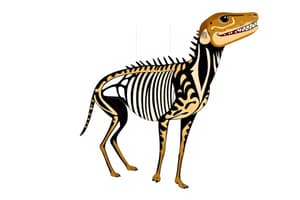Podcast
Questions and Answers
What phylum does Chordata belong to?
What phylum does Chordata belong to?
- Mollusca
- Mammalia
- Arthropoda
- Chordata (correct)
What are some examples of Mammalia?
What are some examples of Mammalia?
Whales, rodents, bats, shrews, moles, primates, cats, dogs, bears, seals
What is a characteristic of Amphibia?
What is a characteristic of Amphibia?
- Cold-blooded (correct)
- Lays eggs in water (correct)
- Has wings
- All of the above
What distinguishes Reptilia?
What distinguishes Reptilia?
Which of the following classes are warm-blooded?
Which of the following classes are warm-blooded?
What do Osteichthyes primarily use to breathe?
What do Osteichthyes primarily use to breathe?
Chondrichthyes have skeletons made of bone.
Chondrichthyes have skeletons made of bone.
What type of reproduction do Porifera exhibit?
What type of reproduction do Porifera exhibit?
Cnidaria are known for which of the following characteristics?
Cnidaria are known for which of the following characteristics?
What is a defining characteristic of Platyhelminthes?
What is a defining characteristic of Platyhelminthes?
Annelida are primarily found in what type of habitats?
Annelida are primarily found in what type of habitats?
What is a characteristic of Mollusca?
What is a characteristic of Mollusca?
What is a key feature of Bivalves?
What is a key feature of Bivalves?
Flashcards are hidden until you start studying
Study Notes
Chordata
- Phylum characterized by four features at some point: pharyngeal slits, dorsal nerve cord, notochord, and post-anal tail.
- Reproductive strategies include nurturing young, building nests, and releasing offspring with no parental care.
- Examples include mammals, fish, amphibians, reptiles, and birds.
Mammalia
- Class defined by the presence of hair, mammary glands for milk production, and three middle ear bones.
- Warm-blooded, with lungs similar to humans and a typical arrangement of seven cervical vertebrae.
- Examples range from whales and rodents to dogs and bears.
Amphibia
- Class comprises cold-blooded animals adaptive to both land and water environments.
- Young breathe through gills; adults rely on lungs, showcasing a transition in respiratory systems.
- Smooth, porous skin is equipped with mucus and poison glands.
- Examples include frogs, toads, salamanders, and newts.
Reptilia
- Class includes tetrapod vertebrates with dry, scale-covered skin and reproduction via eggs laid on land.
- No aquatic larval stage; lack metamorphosis processes.
- Examples include snakes, turtles, and crocodiles.
Aves
- Class represents warm-blooded, two-legged vertebrates with feathers and beaks lacking teeth.
- Possess a unique four-chambered heart and lightweight yet strong skeletal structure.
- Reproduction is sexual, involving hard-shelled eggs.
- Examples include hummingbirds, owls, and penguins.
Osteichthyes
- Class characterized by a bony skeleton, extensive diversity with around 28,000 species.
- Gills for breathing, fins for swimming; 96% of all fish species belong to this class.
- Examples include seahorses and salmon.
Chondrichthyes
- Class consists of jawed fish with cartilaginous skeletons, paired fins, and gills for underwater respiration.
- Heart arranged in series of chambers.
- Examples include sharks and rays.
Porifera
- Phylum of simple, multicellular organisms that exist in aquatic environments, often permanently attached.
- Characterized by no true body symmetry, organs, or nervous system; they are filter feeders.
- Reproduction occurs sexually or asexually.
- Examples are sponges like Euplectella and Euspongia.
Cnidaria
- Phylum includes around 10,000 aquatic organisms with tentacles featuring stinging cells.
- Exhibits two main life stages: polyp and medusa.
- Bilateral symmetry and two cell layers are typical.
- Examples are jellyfish, corals, and anemones.
Platyhelminthes
- Phylum characterized by flat bodies with three tissue layers; they lack a body cavity and specialized circulatory systems.
- Typically bilaterally symmetrical, they reproduce sexually and have varied feeding habits.
- Examples include flatworms and tapeworms.
Annelida
- Phylum consists of segmented invertebrates that inhabit marine environments and consume soil and sediments.
- Reproduction can be asexual through fragmentation or budding.
- Examples include earthworms and leeches.
Mollusca
- Phylum includes invertebrates, many of which are marine, possessing shells and a muscular mantle.
- A radula is present for feeding, while reproduction typically involves laying eggs.
- Divided into 9-10 taxonomic groups, examples include cuttlefish, snails, and scallops.
Bivalve
- Class within Mollusca recognized by two shells and a lack of a distinct head.
- Characterized by a foot used for movement and ctenidia for eating and breathing.
- Examples include clams and oysters.
Studying That Suits You
Use AI to generate personalized quizzes and flashcards to suit your learning preferences.




